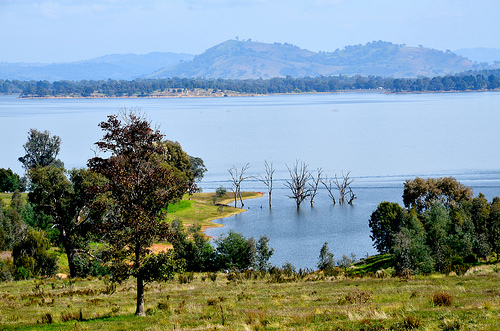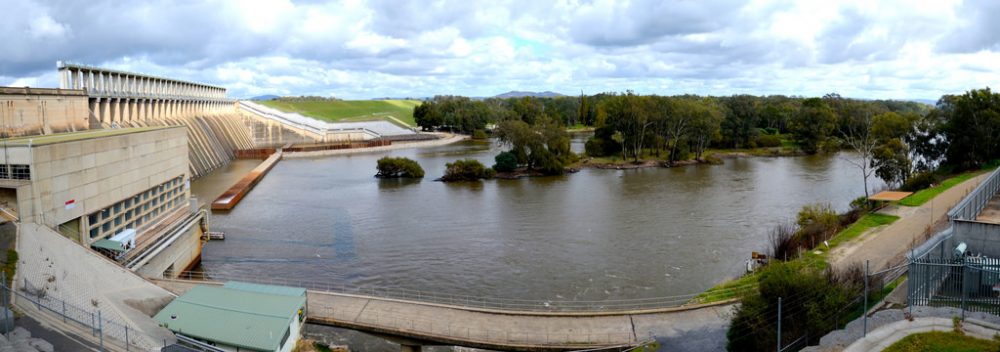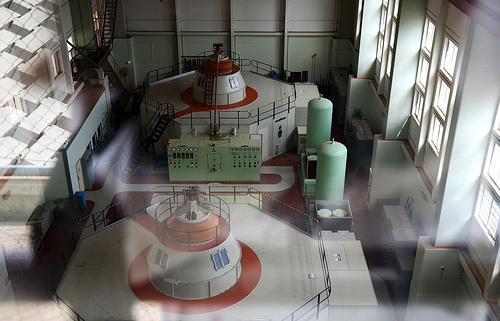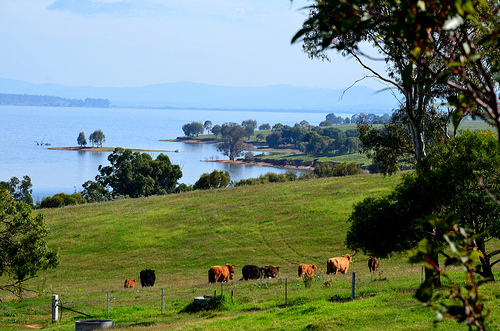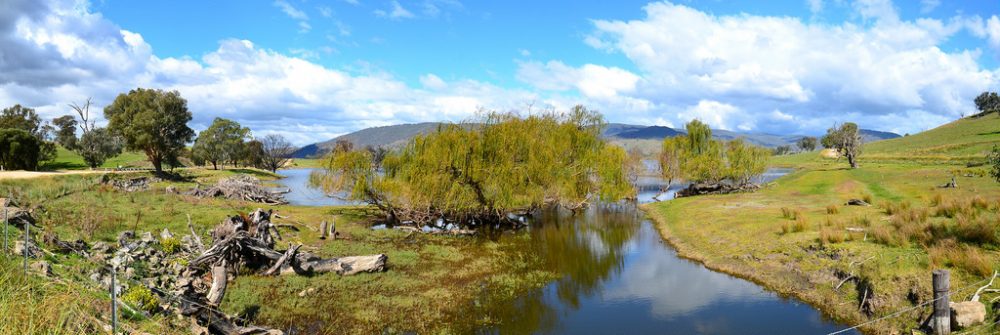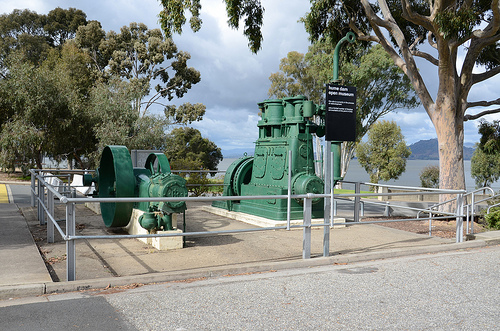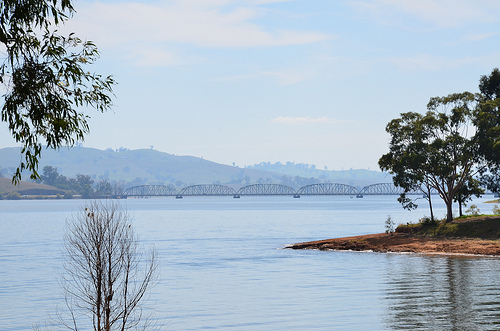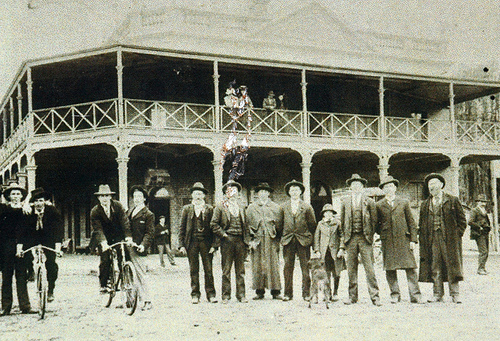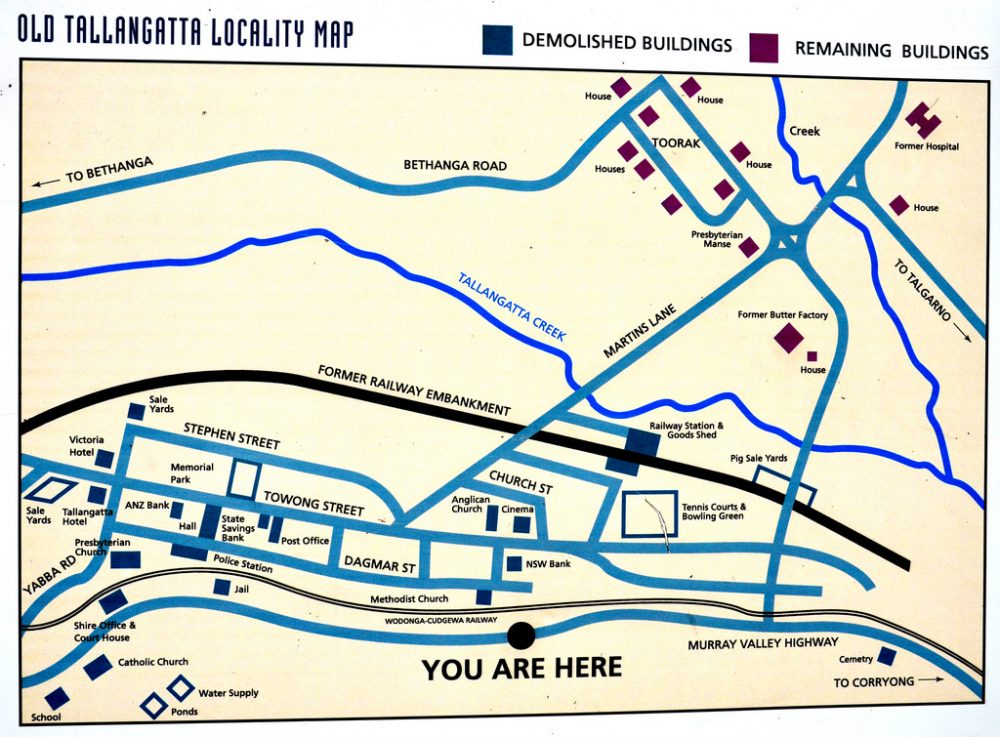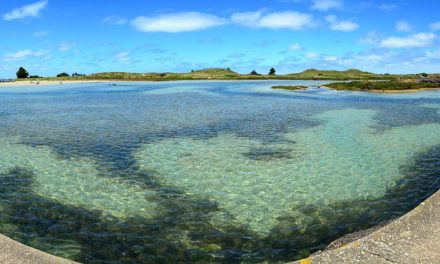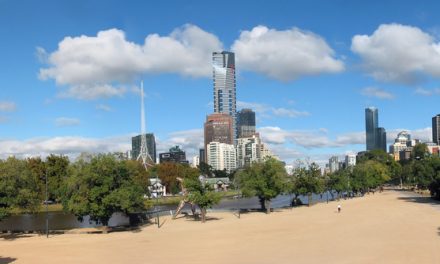I was seeking to spend my long weekend away from Melbourne during the last Easter and was fortunate to book a holiday house at Bellbridge besides Lake Hume only a month prior to check-in. I found Lake Hume to be the most scenic but yet only briefly-mentioned tourist attraction in the Albury-Wondonga region. This low profile may be due to the decade of drought making Lake Hume visually unappealing during periods of low water level. Due to time constraint, I have visited only primarily the Victorian portion of the lake. If I am to return there in the future, I will love to visit the NSW portion.
View Lake Hume in a larger map. Click here to obtain a detailed PDF map.
Lake Hume, located 16 km east of Albury-Wodonga, is an artificial lake formed by the damming of the Murray River just downstream of its junction with the Mitta Mitta River. Often referred to as the Hume Weir, it is only named Lake Hume in the mid 1980s. The small towns of Tallangatta, Bonegilla and Bellbridge are located on the shores of Lake Hume.
History
In 1824, Hamilton Hume became the first European to explore the Murray River upstream of Albury. By the 1860s, landholders were discussing how to better manage the Murray River for navigation, irrigation, flood and drought control. In 1915, the Federal, NSW, Victorian and South Australian Governments approved the River Murray Waters Agreement to regulate the flow of the Murray River as a provision against drought and to ensure that the 3 states received their agreed share of water. The River Murray Commission was created to manage the task of putting the agreement into effect.
The agreement included the construction of a storage on the Upper Murray. The site of Hume Dam was selected from 25 alternatives. The construction commenced on 28 November 1919 and was completed in 1936 after 17 years. The site was originally referred to as the “Mitta Mitta Dam Site” but was renamed “Hume Reservoir” in February 1920 by the River Murray Commission in honour of Hamilton Hume.
In 1924, the Commission agreed to enlarge the Reservoir from its planned capacity of 1,360 GL to 2,470 GL. This was later reduced to 1,540 GL due to the Great Depression. At the peak, over 1000 tradesmen and labourers worked under dangerous conditions to build the dam. While the exact number is unknown, it is believed that up to 9 lives were lost during construction. Horses, steam engines and manual labour were mostly used, with only a handful of motor vehicles used on the project. During the years of the Great Depression, workmen were told to load rocks into trucks using their bare hands, in order to create more work.
When the project was completed in 1936, it was the biggest dam in the Southern Hemisphere and one of the largest in the world. It was hailed alongside Sydney Harbour Bridge as one of the mightiest Australian structures of the inter-war years and was one of the first great inter-government co-operative projects facilitated by the Federation. The dam wall is constructed of rock covered with clay and other earth, with a concrete spillway. It is 51 m high, 1.616 km long and designed to carry vehicular traffic.
Later, the Snowy Mountains Scheme resulted in increased flows in the Murray River and as part of the scheme, it was agreed to double its maximum storage capacity to 3,036.5GL, approximately 5 times the volume of Sydney Harbour. The extension necessitated the wholesale removal of the Tallangatta township and its re-establishment at a new site 8 km west of the original, as well as railway and road diversions. These works were completed in 1961. In 1957, a 58-MW hydro-electric power station was built in the dam wall, primarily used for peak-load power generation from releases.
Monitoring of the dam in the early 1990s revealed that the water pressure and leakage had caused the dam to move on its foundations slightly, leading to concerns that the dam was heading for collapse, threatening Albury-Wodonga and the entire Murray basin with it. Authorities denied any short-term threat. Traffic was banned from the spillway, and a large repair job commenced involving in part, the construction of a secondary earth wall behind the original to take the strain.
Dam Operation
Hume Dam is jointly managed by Victorian and New South Wales authorities on behalf of the Murray Darling Basin Authority. Goulburn-Murray Water manages the water and foreshore land located in Victoria, with the land being public crown land. In NSW, most of the land surrounding the lake is freehold title in private ownership.
Hume Dam is the major operating storage of the River Murray system. The storage regulates the Murray River and the water discharged from the Snowy Mountains Hydro-electric Scheme. Releases from Lake Hume and its downstream tributaries supply water for irrigation, domestic and urban needs of Victoria and NSW, and provide about one-third of South Australia’s entitlement. In very dry years, releases are made specifically for South Australian requirements and are supplemented by transfers from Dartmouth Dam.
Lake Hume follows an annual cycle of filling and drawdown. The reservoir usually receives inflows during winter and fills to at least two-thirds capacity before November in normal years. Releases generally occur between December and May, with the reservoir typically falling to less than one-third capacity by March each year. However, Australia’s highly unpredictable climatic conditions cause these figures to vary quite significantly from year to year. In 2007, Lake Hume fell to a scant 1% capacity, with barely more water than its two component rivers (Murray and Mitta). It is at full capacity as of November 2010.
Lake Recreation
The lake is stocked with fish. Most of these are introduced species – carp, redfin and trout though native species such as Golden Perch and Murray Cod can also be found. The fishing varies from year to year. It is also popular for water skiing, and several holiday resorts catering for fishing and skiers are dotted around the upper reaches of the lake.
Hume Weir Park at the Dam (GPS coordinates S36.105536, E147.034685) has barbeque facilities, tables, an open air museum and viewing platforms. There are also a number of reserves around Lake Hume with picnic and toilet facilities.
Bethanga Bridge
This is the most photographed structure over Lake Hume. It straddles the middle of the reservoir, dividing it into a NSW northern half and a Victorian southern half. It is in fact the only built structure shared by both NSW and Victoria on the Murray River border.
The Bethanga Bridge was built between 1927 and 1930 – a joint venture between NSW and Victoria as part of the Hume Dam project. Measuring 752m long by 7.7m wide, it comprises 9 spans of 82m each and a 14m approach span on the NSW side. Each span is supported between double-reinforced concrete pylons by a riveted steel camel back Pratt truss. The road deck was initially timber but was replaced in 1961 with the current concrete waffle slab deck. In 1961, the bridge deck and truss structure was raised by 300mm in response to the upgrading of Hume Dam for increasing its storage capacity.
(Video of the Bethanga Bridge to be made and inserted here)
The use of Pratt trusses is unusual in Victoria, not being readily taken up as a viable bridge design. However they are more common in NSW. The use of the Pratt truss in this instance reflects the nature of the interstate cooperation. The bridge was designed in NSW by Department of Main Roads engineer Percy Allen and the trusses were built by Vickers Ruwolt in Melbourne.
Bellbridge
This is a small Victorian town of approximately 320 residents, at the western end of the Bethanga Peninsula on the eastern shore of Lake Hume. Overlooking Lake Hume, this compact township is located near the Bethanga Bridge, opposite the Lake Hume Village. The principal road access to the town is from NSW from the Riverina Highway across the Bethanga Bridge. Travel time to Albury by car is approximately 15 minutes.
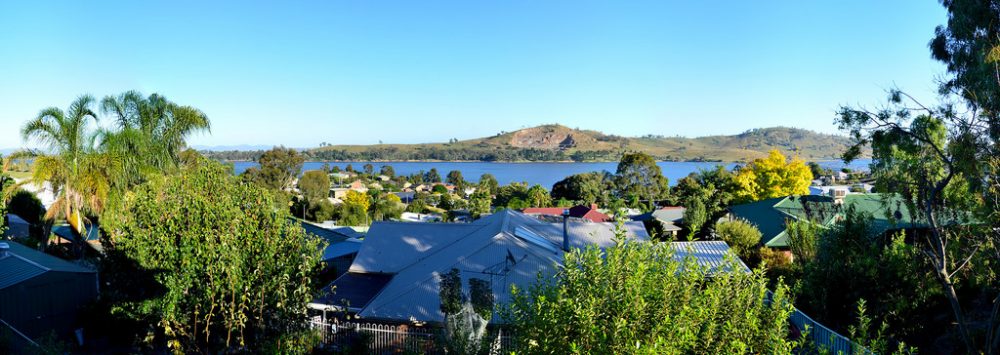
View from Albury-Wodonga Cottage at Bellbridge
The town largely functions as a commuter/retirement settlement to Albury-Wodonga although there is a small holiday element associated with Lake Hume summer activities such as water skiing, boating and fishing.
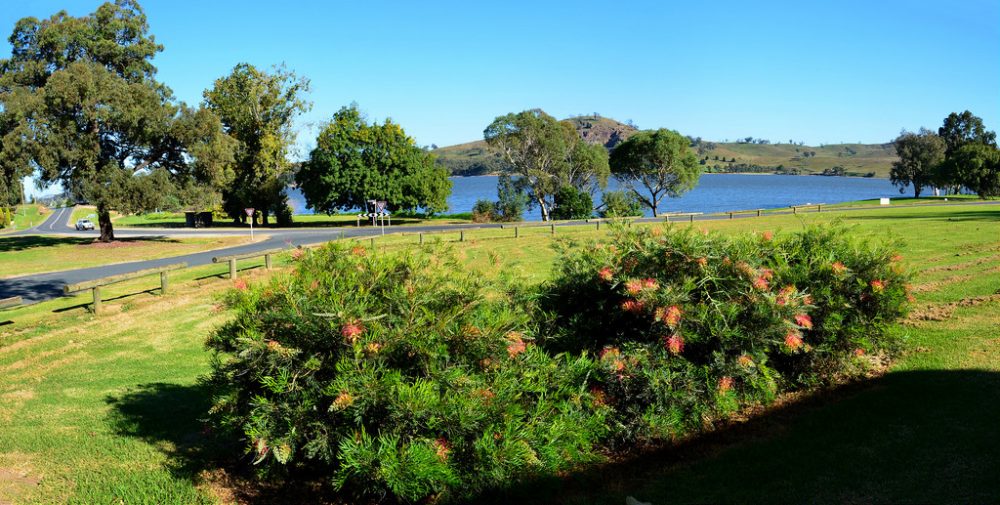
View of Lake Hume from Bellbridge
Tallangatta
This town, with a population of about 950 people, is located on the banks of the Mitta Arm of Lake Hume, about 39 km southeast of Wodonga and 230 m above sea level. It has an interesting historical background, being known as “The Town That Moved“. The original town was established in the 1870s on land which was reputedly the home of the Pallanganmiddang Aborigines. It had a brief brush with fame on 2 April 1865 when “Mad Dan” Morgan, a notorious bushranger, crept into town on a moonless night and stole a racehorse.
The building of the Hume Dam would ultimately inundate this township in the Murray River valley. Hence, the State Rivers and Waters Supply Commission decided to move the township in the late 1940s. Two locations were considered. Toorak just across the valley was the choice of locals because it would leave the town more or less at the same position. However the government rejected this option in case Toorak is flooded by a future reservoir capacity increase. Bolga, a rail siding 8 km to the west was chosen and the moving of almost the entire town commenced in 1954. While most timber buildings were moved, brick houses and other buildings such as hotels, halls and churches were demolished.
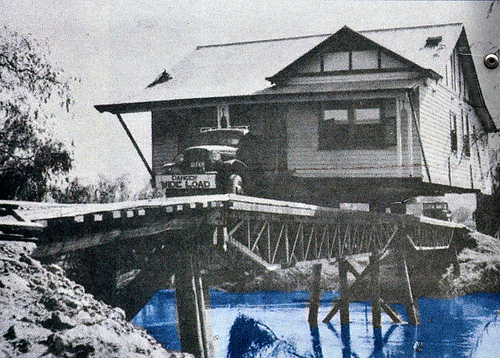
Moving of a timber house to the new township site
There is now a commemorative plaque on the side of the Murray Valley Highway that states the transfer of the township was completed on 29 June 1956.
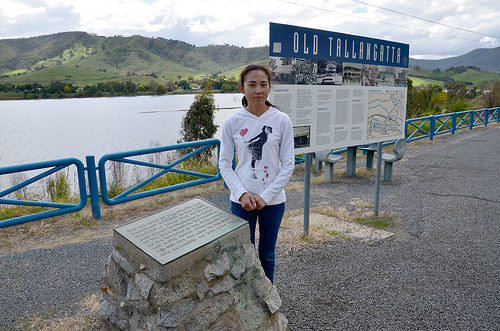
The commemorative plaque and information board
The grid layout of the streets of Old Tallangatta are clearly visible in Google Earth. In 1997, the waters of Lake Hume reached an unprecedented low level. Although 40 years had passed after drowning of the town, it was still possible to see the remnants of the old buildings, such as the foundations of the NSW Bank which once stood on one of the town’s street corners. It was also possible to make out quite clearly the streets, in particular Towong Street, the former Murray Valley Highway, the diagonal road to Toorak and the old railway embankment.
Tallangata today is a delightful town with tree-lined streets overlooking Lake Hume. It supports a small tourist industry, with a motel and caravan park. Many visitors enjoy exploring the town looking for buildings that were relocated in the 1950s. Nearby attractions include Tallangata Lookout, Lake Dartmouth, Mitta Mitta, Mt Granya State Park and Mt Lawson State Park (details here and here).
High Country Rail Trail
This is a historic railway line providing rail services from Wodonga to Cudgewa along Lake Hume from 1887 to 1978. It was used extensively for transporting material for the Snowy Mountain Scheme in the 1960s. Stripped of rails and sleepers, the old railway line now provides a unique 43 km gravel recreational trail for walkers, runners, cyclists and horse riders to enjoy fresh air and scenic views of Lake Hume. A 8 km section between Tallangatta and Old Tallangatta is sealed with other major sections of the trail planned to be sealed in the future.

The disused Bandiana-Cudgewa railway bridge across Sandy Creek Inlet
A current project involves revamping the former Sandy Creek Inlet Rail Bridge near the southern end of Lake Hume to complete the missing link in the section of trail between Wodonga and Tallangatta. The project involves reinstating 30 concrete columns rising 12 m from the lake’s floor, spanned by a 2.8m wide deck and safety rails. Viewing platforms will be built at each end of the bridge to provide areas to rest, take photos and enjoy the scenic countryside around Lake Hume.
Bonegilla Migrant Camp – Block 19
The Bonegilla Migrant Reception and Training Centre was set up on a 130-hectare former WWII army camp near Bonegilla for housing post-war immigrants. The camp received more than 300,000 migrants during its operating period from 1947 to 1971 and over 1.5 million Australians are estimated to descend from these migrants.
The camp had the most basic facilities. It contained 24 blocks each with a communal kitchen, mess hut and bath/toilet blocks. The accommodation itself was in ex-Army unlined timber-framed buildings with corrugated iron walls. The rooms were designed to accommodate 20 people and contained no internal partitions. From 1951 onwards, the internal walls were slowly lined and painted and cubicles installed, allowing some privacy.
The centre was remote from the larger cities and generally attracted little attention from the Australian press, except in 1949 when 13 newly-arrived children died from malnutrition. There were protests about food and conditions in 1952 and Italian and German migrants staged a riot in 1961, smashing the employment office and clashing with police. These events embarrassed Australian authorities, leading to a review of settlement policies. Of the 24 blocks, only Block 19 remains which is now listed under the National Heritage List and functions as a museum and interpretive centre.


